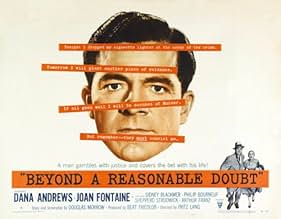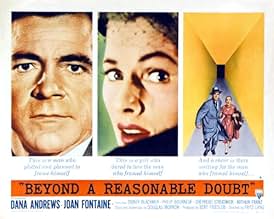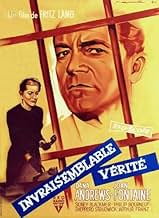VALUTAZIONE IMDb
6,9/10
6270
LA TUA VALUTAZIONE
Aggiungi una trama nella tua linguaA novelist aided by his future father-in-law conspires to frame himself for the murder of a burlesque dancer as part of an effort to ban capital punishment.A novelist aided by his future father-in-law conspires to frame himself for the murder of a burlesque dancer as part of an effort to ban capital punishment.A novelist aided by his future father-in-law conspires to frame himself for the murder of a burlesque dancer as part of an effort to ban capital punishment.
- Regia
- Sceneggiatura
- Star
- Premi
- 1 candidatura in totale
William F. Leicester
- Charlie Miller
- (as William Lester)
Recensioni in evidenza
"Beyond a Reasonable Doubt" is a curious film - it has the look and feel of a B movie and two stars who had seen better days - Dana Andrews and Joan Fontaine - yet it's a good script directed by Fritz Lang. A novelist (Andrews) and his future father-in-law, a newspaper magnet (Sidney Blackmer) work together to prove that the death penalty isn't justified by framing Andrews for a recent murder.
I thought the story excellent with some exciting twists, though the whole movie has an underplayed (not to mention inexpensive) feeling to it. Fontaine seemed a little old for her role. However, she does a good job as a sophisticate, and Andrews is good as well. Barbara Nichols does a fine job in a typical supporting role for her.
Lang returned to Germany after this film, his last in America. It's an effective plot but one wishes the man who made Metropolis and so many other fine films was given more of a budget for his swansong.
I thought the story excellent with some exciting twists, though the whole movie has an underplayed (not to mention inexpensive) feeling to it. Fontaine seemed a little old for her role. However, she does a good job as a sophisticate, and Andrews is good as well. Barbara Nichols does a fine job in a typical supporting role for her.
Lang returned to Germany after this film, his last in America. It's an effective plot but one wishes the man who made Metropolis and so many other fine films was given more of a budget for his swansong.
This film features Dana Andrews as Tom Garrett, a novelist who is facing a deadline by his publisher to complete his next book. His future father-in-law, Austin Spencer, works has an editor for the big newspaper in town. Spencer has enough clout as an editor that he's regularly in touch with the District Attorney and local law enforcement. Spencer is also anti-capital punishment and is often at odds with the DA, who is very much pro-capital punishment. Spencer feels that the DA feels no qualms about sentencing people to death, because he wants to be seen as the man who makes someone pay for whatever crime he's prosecuting--regardless of whether he presents hard evidence or circumstantial.
An execution is presented at the beginning of the film. Through conversations between Garrett and Spencer and later, Garrett, Spencer and the DA, we learn that the DA has been thought of as taking the most inconsequential circumstantial evidence and manipulating it in court to make it seem like hard fact. Spencer feels like the DA often is grasping at straws, but because he wants to be seen as bringing justice to crimes, he is willing to manipulate any jury into a conviction. Spencer questions the DA about letting a potentially innocent man take the fall based on circumstantial evidence and not actual fact. The DA seems nonchalant about the whole thing.
For his book, Spencer suggests to Garrett that he write a book about someone who is convicted of a crime based on circumstantial evidence. 1) It will give Garrett something to write about, and 2) Spencer will hopefully be able to prove his point to the DA that innocent men could be convicted and executed based on circumstantial evidence. The plan is that Garrett and Spencer will find a crime where the police have no leads. They will then plant evidence in order to focus the police attention on Garrett as the possible perpetrator and implicate him in a crime. They're hoping that Garrett will be arrested and brought to trial. Along the way, Spencer and Garrett plan on taking photos of Garrett planting the evidence so that the photos can be presented to the court in the event that Garrett is convicted of the crime.
You just know from the get-go that something is going to go wrong. Otherwise, where's the suspense? What I did not expect was the ending of the film. What a great twist.
Joan Fontaine is rather wasted in her thankless role as Susan Spencer, Andrews' fiancee and daughter of Austin Spencer. Her finest moment in the film is towards the end, but even then, I think many other actresses could have handled the part--it wouldn't have required an Oscar winner.
An execution is presented at the beginning of the film. Through conversations between Garrett and Spencer and later, Garrett, Spencer and the DA, we learn that the DA has been thought of as taking the most inconsequential circumstantial evidence and manipulating it in court to make it seem like hard fact. Spencer feels like the DA often is grasping at straws, but because he wants to be seen as bringing justice to crimes, he is willing to manipulate any jury into a conviction. Spencer questions the DA about letting a potentially innocent man take the fall based on circumstantial evidence and not actual fact. The DA seems nonchalant about the whole thing.
For his book, Spencer suggests to Garrett that he write a book about someone who is convicted of a crime based on circumstantial evidence. 1) It will give Garrett something to write about, and 2) Spencer will hopefully be able to prove his point to the DA that innocent men could be convicted and executed based on circumstantial evidence. The plan is that Garrett and Spencer will find a crime where the police have no leads. They will then plant evidence in order to focus the police attention on Garrett as the possible perpetrator and implicate him in a crime. They're hoping that Garrett will be arrested and brought to trial. Along the way, Spencer and Garrett plan on taking photos of Garrett planting the evidence so that the photos can be presented to the court in the event that Garrett is convicted of the crime.
You just know from the get-go that something is going to go wrong. Otherwise, where's the suspense? What I did not expect was the ending of the film. What a great twist.
Joan Fontaine is rather wasted in her thankless role as Susan Spencer, Andrews' fiancee and daughter of Austin Spencer. Her finest moment in the film is towards the end, but even then, I think many other actresses could have handled the part--it wouldn't have required an Oscar winner.
Fritz Lang's twenty years as a Hollywood refugee, which had started so spiritedly with "Fury", gradually wound down to the grey, listless offering that is "Beyond a Reasonable Doubt". True, Lang's first and last titles have family resemblances. "Fury" concerns a man who may or may not have committed a capital crime but who deserves due process rather than lynching; "Doubt" is about a guy who frames himself to prove that the irrevocable sentence of capital punishment, legal or not, is never justifiable if the law is fallible.
But whereas the argument of "Fury" was driven full steam ahead by a master of montage ("Metropolis") and suspenseful pacing ("M"), "Doubt" consists largely of two- or three-shots of men in suits with "display kerchiefs", arguing in paneled offices with unraised voices. The story has its due ration of twists as Dana Andrews's writer is persuaded by his prospective father-in-law, a crusading press magnate, to set himself up as a burlesque dancer's killer; the two of them will keep records of the plot that are sure to exonerate Andrews before he faces the chair. (Wouldn't he get a stiff sentence for wasting the cops' time, though?)
But the focus shifts awkwardly from Andrews to his girl and lawyer as it unwinds, and the scenario is oddly bare of dramatic crises. For example, the press boss's death occurs off screen and his exoneration is brought in by his lawyer, not tracked down by his daughter, Andrews's fiancée. Only a few backstage scenes with the dancing girls, all peroxide and nasal cynicism, enliven proceedings. Andrews had begun to freeze into the stone faced stolidity which hampered his later career, while 39 year old Fontaine (the classic aging actress's age) is matronly in costume, maquillage and demeanor: encased in stately prissiness like other English ladies of Hollywood such as Garson and Kerr.
Apart from Fontaine the production looks as well as feels impoverished, aesthetically like Ida Lupino's and Collier Young's problem pics but without their punch. The final twist is not signaled strongly enough to give smarter audience members a decent chance of foreseeing it. At one ludicrous moment, the publisher suggests his guests catch up on the day's highlights in Andrews's murder trial: he turns on a TV which immediately and obligingly recounts them, like George Burns's magic set on "The Burns and Allen Show". Incidentally, was covering trials and commenting on them normal for American television c. 1955?
"Beyond a Reasonable Doubt" was a swansong not only for Lang but for RKO. It had abandoned production three years earlier after being wrecked by Howard Hughes, had sold its studio to Desi and Lucy and was now reduced to releasing outside product: in this instance from one Bert Friedlob. It really was time for Herr Lang to catch the plane back to de-Nazified Germany.
But whereas the argument of "Fury" was driven full steam ahead by a master of montage ("Metropolis") and suspenseful pacing ("M"), "Doubt" consists largely of two- or three-shots of men in suits with "display kerchiefs", arguing in paneled offices with unraised voices. The story has its due ration of twists as Dana Andrews's writer is persuaded by his prospective father-in-law, a crusading press magnate, to set himself up as a burlesque dancer's killer; the two of them will keep records of the plot that are sure to exonerate Andrews before he faces the chair. (Wouldn't he get a stiff sentence for wasting the cops' time, though?)
But the focus shifts awkwardly from Andrews to his girl and lawyer as it unwinds, and the scenario is oddly bare of dramatic crises. For example, the press boss's death occurs off screen and his exoneration is brought in by his lawyer, not tracked down by his daughter, Andrews's fiancée. Only a few backstage scenes with the dancing girls, all peroxide and nasal cynicism, enliven proceedings. Andrews had begun to freeze into the stone faced stolidity which hampered his later career, while 39 year old Fontaine (the classic aging actress's age) is matronly in costume, maquillage and demeanor: encased in stately prissiness like other English ladies of Hollywood such as Garson and Kerr.
Apart from Fontaine the production looks as well as feels impoverished, aesthetically like Ida Lupino's and Collier Young's problem pics but without their punch. The final twist is not signaled strongly enough to give smarter audience members a decent chance of foreseeing it. At one ludicrous moment, the publisher suggests his guests catch up on the day's highlights in Andrews's murder trial: he turns on a TV which immediately and obligingly recounts them, like George Burns's magic set on "The Burns and Allen Show". Incidentally, was covering trials and commenting on them normal for American television c. 1955?
"Beyond a Reasonable Doubt" was a swansong not only for Lang but for RKO. It had abandoned production three years earlier after being wrecked by Howard Hughes, had sold its studio to Desi and Lucy and was now reduced to releasing outside product: in this instance from one Bert Friedlob. It really was time for Herr Lang to catch the plane back to de-Nazified Germany.
While Sidney Blackmer and Dana Andrews cook up and carry out their scheme to prove that an innocent person can be convicted of a murder, everyone ignores the fact that, by getting this innocent person convicted, they're helping the real murderer escape justice. Just sayin'.
Tom Garrett is a writer engaged to the daughter of wealthy newspaper man Austin Spencer. Spencer is also firmly against the death penalty. With Tom looking for a subject for a second novel, Spencer suggests that they set Tom up for an unsolved murder using circumstantial evidence to prove how easy it would be for the courts to kill an innocent man. Once Tom is sentenced to the chair, Spencer will expose the failings in the system and free him. However when Spencer is killed in car crash and none of the evidence can be found then Tom faces the chair.
A very interesting concept still needs a good delivery to make for a good film. This not only had a good idea but it was also a fair point to be made about the death penalty. The film moves along with a good build up for the whole first half. However once Tom finds himself in real trouble then the film strangely doesn't manage to deliver as much tension as it really should have done. Conversely the film becomes more of a melodrama for a while and it loses a lot of momentum. There are some nice touches at the end but they can't completely make up for the weaknesses in the middle section.
It is quite atmospheric but not to the point that I had hoped but Lang does a good job on direction. The cast are OK. Andrews has long been one of my favourite actors from the period and he gives a solid if unspectacular show here. Fontaine is weaker and doesn't quite convince as well as Andrews but is fine. Blackmer is pretty enjoyable as Austin Spencer and Ed Binns is a familiar face as Lt. Kennedy.
It doesn't quite work as you'd hope as the tension drops off at the exactly the moment that it needs to step up a notch. It is worth watching but it is not one of Lang's better films.
A very interesting concept still needs a good delivery to make for a good film. This not only had a good idea but it was also a fair point to be made about the death penalty. The film moves along with a good build up for the whole first half. However once Tom finds himself in real trouble then the film strangely doesn't manage to deliver as much tension as it really should have done. Conversely the film becomes more of a melodrama for a while and it loses a lot of momentum. There are some nice touches at the end but they can't completely make up for the weaknesses in the middle section.
It is quite atmospheric but not to the point that I had hoped but Lang does a good job on direction. The cast are OK. Andrews has long been one of my favourite actors from the period and he gives a solid if unspectacular show here. Fontaine is weaker and doesn't quite convince as well as Andrews but is fine. Blackmer is pretty enjoyable as Austin Spencer and Ed Binns is a familiar face as Lt. Kennedy.
It doesn't quite work as you'd hope as the tension drops off at the exactly the moment that it needs to step up a notch. It is worth watching but it is not one of Lang's better films.
Lo sapevi?
- QuizFinal American film made by Fritz Lang before returning to Germany. It was a box-office failure.
- BlooperWHile the trial is shown on TV there is a frontal shot of Tom sitting at the defendants desk. This would not be possible as the television camera was stationed behind and to the side of the desk. It's not feasible that the large 1950's era television camera would have been moved to the front of the courtroom for the shot.
- Citazioni
Tom Garrett: Well, could I get in touch with you?
Dolly Moore: You've touched enough already!
- ConnessioniFeatured in Private Property (1960)
- Colonne sonoreBeyond A Reasonable Doubt
Sung by The Hi-Los (as The Hi-Lo's)
Music by Herschel Burke Gilbert
Lyrics by Alfred Perry
I più visti
Accedi per valutare e creare un elenco di titoli salvati per ottenere consigli personalizzati
- How long is Beyond a Reasonable Doubt?Powered by Alexa
Dettagli
- Data di uscita
- Paese di origine
- Lingua
- Celebre anche come
- Más allá de la duda
- Luoghi delle riprese
- Chicago, Illinois, Stati Uniti(location shooting)
- Azienda produttrice
- Vedi altri crediti dell’azienda su IMDbPro
- Tempo di esecuzione1 ora 20 minuti
- Colore
Contribuisci a questa pagina
Suggerisci una modifica o aggiungi i contenuti mancanti

Divario superiore
By what name was L'alibi era perfetto (1956) officially released in India in English?
Rispondi




































